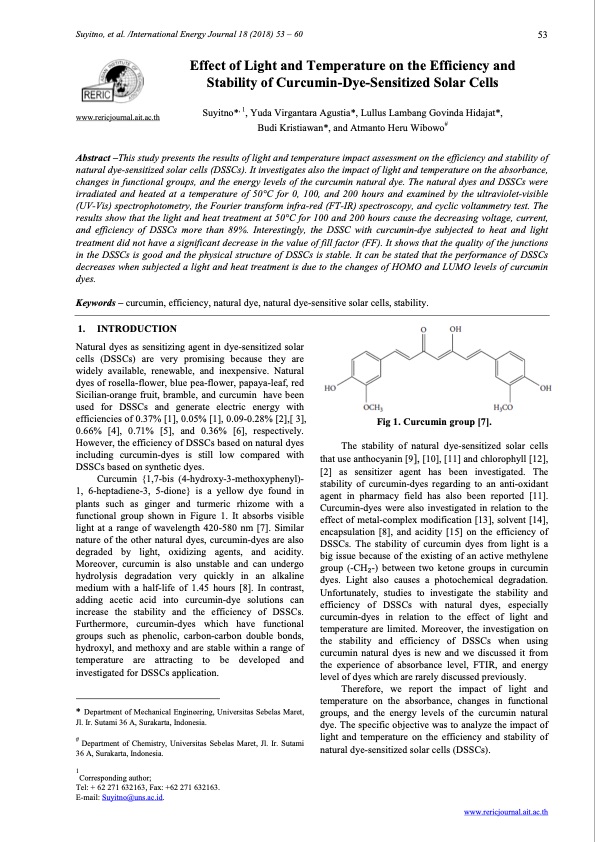PDF Publication Title:
Text from PDF Page: 001
Suyitno, et al. /International Energy Journal 18 (2018) 53 – 60 53 Effect of Light and Temperature on the Efficiency and www.rericjournal.ait.ac.th Stability of Curcumin-Dye-Sensitized Solar Cells Suyitno*, 1, Yuda Virgantara Agustia*, Lullus Lambang Govinda Hidajat*, Budi Kristiawan*, and Atmanto Heru Wibowo# Abstract –This study presents the results of light and temperature impact assessment on the efficiency and stability of natural dye-sensitized solar cells (DSSCs). It investigates also the impact of light and temperature on the absorbance, changes in functional groups, and the energy levels of the curcumin natural dye. The natural dyes and DSSCs were irradiated and heated at a temperature of 50°C for 0, 100, and 200 hours and examined by the ultraviolet-visible (UV-Vis) spectrophotometry, the Fourier transform infra-red (FT-IR) spectroscopy, and cyclic voltammetry test. The results show that the light and heat treatment at 50°C for 100 and 200 hours cause the decreasing voltage, current, and efficiency of DSSCs more than 89%. Interestingly, the DSSC with curcumin-dye subjected to heat and light treatment did not have a significant decrease in the value of fill factor (FF). It shows that the quality of the junctions in the DSSCs is good and the physical structure of DSSCs is stable. It can be stated that the performance of DSSCs decreases when subjected a light and heat treatment is due to the changes of HOMO and LUMO levels of curcumin dyes. Keywords – curcumin, efficiency, natural dye, natural dye-sensitive solar cells, stability. 11. INTRODUCTION Natural dyes as sensitizing agent in dye-sensitized solar cells (DSSCs) are very promising because they are widely available, renewable, and inexpensive. Natural dyes of rosella-flower, blue pea-flower, papaya-leaf, red Sicilian-orange fruit, bramble, and curcumin have been used for DSSCs and generate electric energy with efficiencies of 0.37% [1], 0.05% [1], 0.09-0.28% [2],[ 3], 0.66% [4], 0.71% [5], and 0.36% [6], respectively. However, the efficiency of DSSCs based on natural dyes including curcumin-dyes is still low compared with DSSCs based on synthetic dyes. Curcumin {1,7-bis (4-hydroxy-3-methoxyphenyl)- 1, 6-heptadiene-3, 5-dione} is a yellow dye found in plants such as ginger and turmeric rhizome with a functional group shown in Figure 1. It absorbs visible light at a range of wavelength 420-580 nm [7]. Similar nature of the other natural dyes, curcumin-dyes are also degraded by light, oxidizing agents, and acidity. Moreover, curcumin is also unstable and can undergo hydrolysis degradation very quickly in an alkaline medium with a half-life of 1.45 hours [8]. In contrast, adding acetic acid into curcumin-dye solutions can increase the stability and the efficiency of DSSCs. Furthermore, curcumin-dyes which have functional groups such as phenolic, carbon-carbon double bonds, hydroxyl, and methoxy and are stable within a range of temperature are attracting to be developed and investigated for DSSCs application. * Department of Mechanical Engineering, Universitas Sebelas Maret, Jl. Ir. Sutami 36 A, Surakarta, Indonesia. # Department of Chemistry, Universitas Sebelas Maret, Jl. Ir. Sutami 36 A, Surakarta, Indonesia. 1Corresponding author; Tel: + 62 271 632163, Fax: +62 271 632163. E-mail: Suyitno@uns.ac.id. Fig 1. Curcumin group [7]. The stability of natural dye-sensitized solar cells that use anthocyanin [9], [10], [11] and chlorophyll [12], [2] as sensitizer agent has been investigated. The stability of curcumin-dyes regarding to an anti-oxidant agent in pharmacy field has also been reported [11]. Curcumin-dyes were also investigated in relation to the effect of metal-complex modification [13], solvent [14], encapsulation [8], and acidity [15] on the efficiency of DSSCs. The stability of curcumin dyes from light is a big issue because of the existing of an active methylene group (-CH2-) between two ketone groups in curcumin dyes. Light also causes a photochemical degradation. Unfortunately, studies to investigate the stability and efficiency of DSSCs with natural dyes, especially curcumin-dyes in relation to the effect of light and temperature are limited. Moreover, the investigation on the stability and efficiency of DSSCs when using curcumin natural dyes is new and we discussed it from the experience of absorbance level, FTIR, and energy level of dyes which are rarely discussed previously. Therefore, we report the impact of light and temperature on the absorbance, changes in functional groups, and the energy levels of the curcumin natural dye. The specific objective was to analyze the impact of light and temperature on the efficiency and stability of natural dye-sensitized solar cells (DSSCs). www.rericjournal.ait.ac.thPDF Image | Curcumin-Dye-Sensitized Solar Cells

PDF Search Title:
Curcumin-Dye-Sensitized Solar CellsOriginal File Name Searched:
10988664.pdfDIY PDF Search: Google It | Yahoo | Bing
Salgenx Redox Flow Battery Technology: Salt water flow battery technology with low cost and great energy density that can be used for power storage and thermal storage. Let us de-risk your production using our license. Our aqueous flow battery is less cost than Tesla Megapack and available faster. Redox flow battery. No membrane needed like with Vanadium, or Bromine. Salgenx flow battery
CONTACT TEL: 608-238-6001 Email: greg@salgenx.com (Standard Web Page)